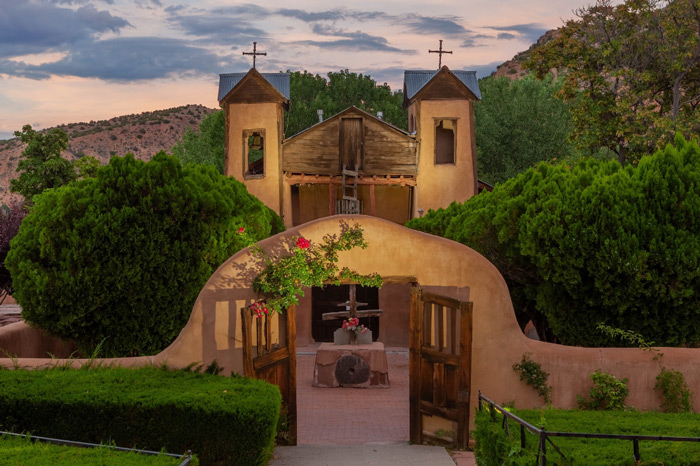El Santuario de Chimayó: The Enchanting Healing Shrine in New Mexico
El Santuario de Chimayó is a one-of-a-kind, historic Roman Catholic church complex in northern New Mexico, rumored to possess healing powers originating from the holy dirt distributed in one of its shrines. Mysteries aside, the iconic shrine with thick adobe walls is one of the best-preserved examples of Spanish Colonial architecture in New Mexico and a National Historic Landmark, bound to please even skeptics and non-believers.
El Santuario de Chimayó is situated in the foothills of the west slope of the Sangre de Cristo Mountains in a small rural village of Chimayó, New Mexico, about 25 miles north of Santa Fe along the High Road to Taos Scenic Byway.
Though tucked away in a rural area of the state that generally evades tourist crowds, El Santuario de Chimayó is one of the most important Catholic pilgrimage sites in the world (often referred to as the “Lourdes of America”) and one of the most visited holy sites in the United States.
Each year during Holy Week and in particular on Good Friday, the tiny village of Chimayó swells up with tens of thousands of pilgrims who make their way to the Santuario from near and afar, some even barefoot, as part of centuries-long Easter tradition.

Visiting El Santuario de Chimayó
There are 4 different chapels on the El Santuario de Chimayó grounds. The two main ones are the Lord of Esquipulas Chapel and the Santo Niño de Atocha Chapel.
The Shrine of Our Lord of Esquipulas

The Lord of Esquipulas Chapel is the main attraction here and the site of El Pocito, the repository of holy dirt that has made the village of Chimayó famous. This quaint chapel, built in 1816 of adobe, is entered through a walled courtyard.


The shrine is cozy and colorful, down a few shallow steps past a large entryway with rustic wooden doors. Photography is not allowed inside, of which we were promptly informed, so the one picture below from the entryway is all we have to share.

At the far left end of the shrine, a door opens up to a second room from which you can immediately enter yet another room, a very small one, not much bigger than a walk-in closet. This tiny room has an equally undersized entrance door and a small round pit in the middle of the floor, filled with fine-grained sandy soil.
That’s el pocito (“the little well”), the source of the holy dirt, believed by many to possess remarkable curative properties. Read on for instructions on how to use it personally.
The second room adjacent to the shrine is filled with religious objects and personal talismans, together with a wall collection of discarded crutches, left behind by those healed by the miraculous soil.
There, plastered all over the walls hang photographs with testimonies of healings as well as prayer requests of those still in need of a miracle, as well as pictures displaying birth and death dates of the loved ones lost. Thousands of beautiful faces pinned to the walls. So many innocent children here. So many babies.
The feeling of grief over the losses mourned is intense in this room; I don’t know if anyone leaves with a dry eye. Yet, amidst the sorrow, there is an overwhelming sense of love and hope. You can almost hear the lines of prayers bouncing off the walls in this room.

The Shrine of Santo Niño de Atocha
The Santo Niño de Atocha Chapel (Holy Child of Atocha Chapel) is located a short walking distance from the sacred Santuario. It’s dedicated to the Holy Child of Atocha, whose devotion has roots in Spain. This shrine, constructed in 1857, is another chapel of historical significance, tied to the Chimayó annual pilgrimage.

Two more chapels
Two additional chapels on the grounds, Holy Family Chapel and Native American Chapel, are also well worth a visit.
The Holy Family Chapel is situated near the Santo Niño Chapel.
In the Native American Chapel, accessible from the sanctuary garden, more photographs of loved ones with special prayer requests line the walls.

Garden
To the back of the Santuario you’ll find a colorful, peaceful garden adorned with giant cottonwoods and various pieces of religious artwork. Thousands of crosses, rosaries, and personal talismans festoon the structures and trees.



Things to do nearby
Aside from the famous shrine and its sacred sand pit, Chimayó is known for traditional Hispanic and Tewa Indian arts, particularly for its rich weaving history that goes back several centuries. You can buy a variety of hand woven textiles in the village, made with the same passion and precision that has been passed from one generation to another.
The little historic village of Chimayó is also famous for the Chimayó Chile pepper. It’s grown right here in small batches from the original heirloom seeds and sold at virtually every corner around the Santuario.

There are quite a few artisan shops in the vicinity of the shrine with lots of interesting offerings and sights. Just the road that leads to the Santuario makes for an interesting walk.


Additionally, Chimayó is only about an hour-drive from Bandelier National Monument and its unique prehistoric village of Tsankawi, an unexcavated ancient pueblo.

The origins of the Chimayó healing shrine
A handful of stories revolve around how the Chimayó shrine came to be, but the following one seems to be the most widely accepted one.

The mysterious crucifix
Legend has it that in 1810 on the evening of Good Friday, a local friar Don Bernardo Abeyta (1771–1856) took note of a strange bright light on his property. After a bit of sleuthing he discovered that the light was coming from the ground along one of the hills. Digging into the soil at that spot with nothing but his bare hands, he unearthed a massive 6-foot-tall wooden crucifix.
Intrigued, Abeyta turned the crucifix over to a local priest who placed it on the altar in his chapel in nearby Santa Cruz.
Mysteriously, the crucifix vanished from its spot overnight and reappeared in Chimayó at the original site. This happened not once, but three times. Abeyta figured the crucifix was not meant to be relocated, and in the same year he established a small chapel to house the crucifix, which he dedicated to the Christ of Esquipulas.
The Chimayó crucifix lured in numerous visitors, and rubbing hands in the soil where it emerged appeared to spark miraculous healings. Soon, news of the ‘healing dirt’ spread, drawing in more curious individuals eager to experience its wonders, leading to the replacement of the small chapel with a larger, current shrine in 1816.
The pit with holy dirt in the Santuario is believed to authentically mark the exact spot from which the peculiar crucifix sprang all those years ago, while the crucifix is housed on the main altar of the present Chimayó shrine.

A Guatemalan priest theory
For those not in favor of pious legends, there is a reasonable explanation of how the famous crucifix could have appeared out of thin air in the Chimayó valley.

The word is, based on craftsmanship, the crucifix was likely brought to Chimayó by a missionary priest from Esquipulas, Guatemala. The priest accompanied the first Spanish settlers and attempted to evangelize the natives that inhabited the Chimayó valley at the time, the Tewa people. He died shortly after arriving (some say he was killed by the natives) and was laid to rest in Chimayó along with his crucifix.
Subsequently, the crucifix might have become partially exposed, either through natural erosion or in conjunction with a flood in 1810, ultimately leading to its discovery.
Tewa legends
Interestingly, the Chimayó valley appears to have been a place of healing long before the famous chapel was built.
Prior to the arrival of the Spanish settlers, this area was inhabited by the Tewa Pueblo people (Tewa-speaking Ancestral Puebloan culture) who had sacred sites on several hills in the Chimayó valley. They believed that the soil on these hills had healing properties.
The natives named one of these sacred hills Tsi-Mayoh, which just so happens to be the hill that lies directly behind the church. This is also how the village of Chimayó got its name.

How to use Chimayó Holy Dirt
Traditionally, the holy dirt of Chimayó was often consumed, either straight up or mixed with water, which the Santuario strongly advises against in present times. Instead, it’s recommended to rub the dirt on the afflicted parts of the body alongside a prayer. Ultimately, some visitors believe that just having the holy dirt in their possession provides the healing or protection needed.
You can collect the holy dirt in a container (a ziplock bag will suffice) and take it home with you. If you don’t have a container, you can buy one there. The fabled dirt is regularly replenished from an unspecified location outside the church and blessed by a priest thereafter.
For what it’s worth, the church remains neutral on the curative properties of its highly sought-after soil, alluding that miraculous healings come to be through faith and divine grace rather than the dirt itself.
Know before you go:
- Address: 15 Santuario Drive, Chimayó, NM 87522
- Fees: No fee to enter; donations accepted.
- Hours: Santuario de Chimayó is open daily 9-5 Oct-Apr and 9-6 May-Sep. Visit the Santuario website for details on other chapels and current happenings. There is a gift shop here and a welcome center with hours posted on the website.
- Parking: A few spots are available near the courtyard entrance, with a larger parking lot SE of the church, just one street down.
- Traveling with a pet? It appears that dogs are permitted on the grounds but not inside the churches (source).
- Safety: The crime rate in Chimayó is higher than the national average. While relatively safe for visitors, this region has its fair share of drug problems and drug-related violent crimes, so it’s probably not a place to go poking around if you don’t know the area well, especially after dark.
- Food: There is only one restaurant in town, but it’s probably one of the most authentic New Mexican dining experiences in the state. (Honest opinion: The food was just OK, but the ambiance alone is well worth the trip.)
If you’re looking to add one-of-a-kind destinations to your American Southwest bucket list, El Santuario de Chimayó should definitely be considered.
Religion aside, there is something about this place. You can be a full-fledged atheist and still enjoy this place and even leave a better person. Whether the holy dirt has miraculous healing powers or not, I’ll let you be the judge…










And all the time tha I was praying
within this church of so much pride.
I felt that as I talked to Heaven
Jesus was sitting at my side.
The feeling was Heavenlly so I wrote a short
poem about my visit. The above is merely an excerpt
of the poem.
That is a very lovely poem, and so is your website. 🙂